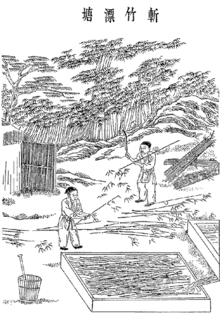History of paper
Paper is a thin nonwoven material traditionally made from a combination of milled plant and textile fibres. It is primarily used for writing, artwork, and packaging; it is commonly white. The first papermaking process was documented in China during the Eastern Han period (25–220 AD) traditionally attributed to the court official Cai Lun. During the 8th century, Chinese papermaking spread to the Islamic world, where pulp mills and paper mills were used for papermaking and money making. By the 11th century, papermaking was brought to Europe. By the 13th century, papermaking was refined with paper mills utilizing waterwheels in Spain. Later European improvements to the papermaking process came in the 19th century with the invention of wood-based papers.
Although precursors such as papyrus and amate existed in the Mediterranean world and pre-Columbian Americas, respectively, these materials are not defined as true paper.[1] Nor is true parchment considered paper;[lower-alpha 1] used principally for writing, parchment is heavily prepared animal skin that predates paper and possibly papyrus. In the twentieth century with the advent of plastic manufacture some plastic "paper" was introduced, as well as paper-plastic laminates, paper-metal laminates, and papers infused or coated with different products that give them special properties.
Precursors: papyrus
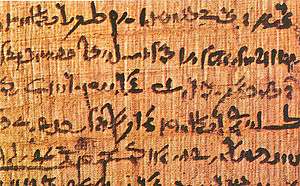
The word "paper" is etymologically derived from papyrus, Ancient Greek for the Cyperus papyrus plant. Papyrus is a thick, paper-like material produced from the pith of the Cyperus papyrus plant which was used in ancient Egypt and other Mediterranean societies for writing long before paper was used in China.[2]
Papyrus is prepared by cutting off thin ribbon-like strips of the interior of the Cyperus papyrus, and then laying out the strips side-by-side to make a sheet. A second layer is then placed on top, with the strips running at right angle to the first. The two layers are then pounded together into a sheet. The result is very strong, but has an uneven surface, especially at the edges of the strips. When used in scrolls, repeated rolling and unrolling causes the strips to come apart again, typically along vertical lines. This effect can be seen in many ancient papyrus documents.[3]
Paper contrasts with papyrus in that the plant material is broken down through maceration or disintegration before the paper is pressed. This produces a much more even surface, and no natural weak direction in the material which falls apart over time.[3]
It is lucky chance that the date of CE 105 was recorded, because Cai Lun, the official involved, who seems to have introduced some improvements in paper manufacture, worked at the palace as a eunuch. Yet just because the new technology was not trumpeted at the time does not mean that it had no effect. On the contrary: up to this point China was lagging behind those Mediterranean societies where papyrus was used and where light, inexpensive scrolls could be created. But thereafter the advantage swung the other way, since papyrus, which is composed of organic material not as highly processed as paper, was prone to splitting and deterioration at a much greater rate; this may be why vellum eventually came to dominate, especially in the harsher climate of Northern Europe. Paper, by contrast, gave a good, uniform writing surface that could be smoothly rolled and unrolled without damage, while remaining relatively durable.[1]
— T.H. Barrett
Paper in China
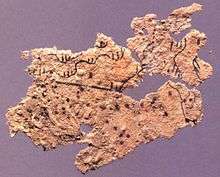
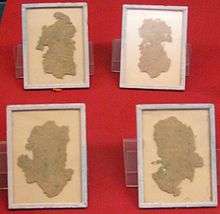
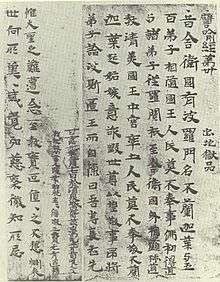
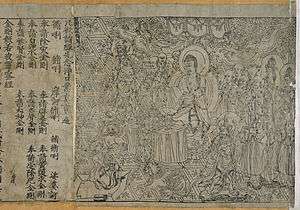
Archaeological evidence of papermaking predates the traditional attribution given to Cai Lun,[4] an imperial eunuch official of the Han dynasty (202 BCE – CE 220), thus the exact date or inventor of paper can not be deduced. The earliest extant paper fragment was unearthed at Fangmatan in Gansu province, and was likely part of a map, dated to 179–141 BCE.[5] Fragments of paper have also been found at Dunhuang dated to 65 BCE and at Yumen pass, dated to 8 BCE.[6]
"Cai Lun's" invention, recorded hundreds of years after it took place, is dated to 105 CE. The innovation is a type of paper made of mulberry and other bast fibres along with fishing nets, old rags, and hemp waste which reduced the cost of paper production, which prior to this, and later, in the West, depended solely on rags.[6][7][1]
Techniques
During the Shang (1600–1050 BCE) and Zhou (1050–256 BCE) dynasties of ancient China, documents were ordinarily written on bone or bamboo (on tablets or on bamboo strips sewn and rolled together into scrolls), making them very heavy, awkward, and hard to transport. The light material of silk was sometimes used as a recording medium, but was normally too expensive to consider. The Han dynasty Chinese court official Cai Lun (c. 50–121 CE) is credited as the inventor of a method of papermaking (inspired by wasps and bees) using rags and other plant fibers in 105 CE.[1] However, the discovery of specimens bearing written Chinese characters in 2006 at Fangmatan in north-east China's Gansu Province suggests that paper was in use by the ancient Chinese military more than 100 years before Cai, in 8 BCE, and possibly much earlier as the map fragment found at the Fangmatan tomb site dates from the early 2nd century BCE.[5] It therefore would appear that "Cai Lun's contribution was to improve this skill systematically and scientifically, fix a recipe for papermaking".[8]
The record in the Twenty-Four Histories says[9]
- In ancient times writings and inscriptions were generally made on tablets of bamboo or on pieces of silk called chih. But silk being costly and bamboos heavy they were not convenient to use. Tshai Lun then initiated the idea of making paper from the bark of trees, remnants of hemp, rags of cloth and fishing nets. He submitted the process to the emperor in the first year of Yuan-Hsing (105 CE) and received praise for his ability. From this time, paper has been in use everywhere and is universally called the paper of Marquis Tshai.
The production process may have originated from the practice of pounding and stirring rags in water, after which the matted fibres were collected on a mat. The bark of paper mulberry was particularly valued and high quality paper was developed in the late Han period using the bark of tan (檀; sandalwood). In the Eastern Jin period a fine bamboo screen-mould treated with insecticidal dye for permanence was used in papermaking. After printing was popularized during the Song dynasty the demand for paper grew substantially. In the year 1101, 1.5 million sheets of paper were sent to the capital.[9]
Uses
Open, it stretches; closed, it rolls up. it can be contracted or expanded; hidden away or displayed.[6]
— Fu Xian
Among the earliest known uses of paper was padding and wrapping delicate bronze mirrors according to archaeological evidence dating to the reign of Emperor Wu of Han from the 2nd century BCE.[10] Padding doubled as both protection for the object as well as the user in cases where poisonous "medicine" were involved, as mentioned in the official history of the period.[10] Although paper was used for writing by the 3rd century CE,[11] paper continued to be used for wrapping (and other) purposes. Toilet paper was used in China from around the late 6th century.[12] In 589, the Chinese scholar-official Yan Zhitui (531–591) wrote: "Paper on which there are quotations or commentaries from Five Classics or the names of sages, I dare not use for toilet purposes".[12] An Arab traveler who visited China wrote of the curious Chinese tradition of toilet paper in 851, writing: "... [the Chinese] do not wash themselves with water when they have done their necessities; but they only wipe themselves with paper".[12]
During the Tang dynasty (618–907) paper was folded and sewn into square bags to preserve the flavor of tea. In the same period, it was written that tea was served from baskets with multi-colored paper cups and paper napkins of different size and shape.[10] During the Song dynasty (960–1279) the government produced the world's first known paper-printed money, or banknote (see Jiaozi and Huizi). Paper money was bestowed as gifts to government officials in special paper envelopes.[12] During the Yuan dynasty (1271–1368), the first well-documented Europeans in Medieval China, the Venetian merchant Marco Polo remarked how the Chinese burned paper effigies shaped as male and female servants, camels, horses, suits of clothing and armor while cremating the dead during funerary rites.[13]
Impact of paper
According to Timothy Hugh Barrett, paper played a pivotal role in early Chinese written culture, and a "strong reading culture seems to have developed quickly after its introduction, despite political fragmentation."[14] Indeed, the introduction of paper had immense consequences for the book world. It meant books would no longer have to be circulated in small sections or bundles, but in their entirety. Books could now be carried by hand rather than transported by cart. As a result, individual collections of literary works increased in the following centuries.[15]
Textual culture seems to have been more developed in the south by the early 5th century, with individuals owning collections of several thousand scrolls. In the north an entire palace collection might have been only a few thousand scrolls in total.[16] By the early 6th century, scholars in both the north and south were capable of citing upwards of 400 sources in commentaries on older works.[17] A small compilation text from the 7th century included citations to over 1,400 works.[18]
The personal nature of texts was remarked upon by a late 6th century imperial librarian. According to him, the possession of and familiarity with a few hundred scrolls was what it took to be socially accepted as an educated man.[19]
According to Endymion Wilkinson, one consequence of the rise of paper in China was that "it rapidly began to surpass the Mediterranean empires in book production."[6] During the Tang dynasty, China became the world leader in book production. In addition the gradual spread of woodblock printing from the late Tang and Song further boosted their lead ahead of the rest of the world.[20]
From the fourth century CE to about 1500, the biggest library collections in China were three to four times larger than the largest collections in Europe. The imperial government book collections in the Tang numbered about 5,000 to 6,000 titles (89,000 juan) in 721. The Song imperial collections at their height in the early twelfth century may have risen to 4,000 to 5,000 titles. These are indeed impressive numbers, but the imperial libraries were exceptional in China and their use was highly restricted. Only very few libraries in the Tang and Song held more than one or two thousand titles (a size not even matched by the manuscript collections of the grandest of the great cathedral libraries in Europe).[21]
— Endymion Wilkinson
However, despite the initial advantage afforded to China by the paper medium, by the 9th century its spread and development in the middle east had closed the gap between the two regions. Between the 9th to early 12th centuries, libraries in Cairo, Baghdad, and Cordoba held collections larger than even the ones in China, and dwarfed those in Europe. From about 1500 the maturation of paper making and printing in Southern Europe also had an effect in closing the gap with the Chinese. The Venetian Domenico Grimani's collection numbered 15,000 volumes by the time of his death in 1523. After 1600, European collections completely overtook those in China. The Bibliotheca Augusta numbered 60,000 volumes in 1649 and surged to 120,000 in 1666. In the 1720s the Bibliothèque du Roi numbered 80,000 books and the Cambridge University 40,000 in 1715. After 1700, libraries in North America also began to overtake those of China, and toward the end of the century, Thomas Jefferson's private collection numbered 4,889 titles in 6,487 volumes. The European advantage only increased further into the 19th century as national collections in Europe and America exceeded a million volumes while a few private collections, such as that of Lord Acton, reached 70,000.[21]
European book production began to catch up with China after the introduction of the mechanical printing press in the mid fifteenth century. Reliable figures of the number of imprints of each edition are as hard to find in Europe as they are in China, but one result of the spread of printing in Europe was that public and private libraries were able to build up their collections and for the first time in over a thousand years they began to match and then overtake the largest libraries in China.[20]
— Endymion Wilkinson
Paper became central to the three arts of China – poetry, painting, and calligraphy. In later times paper constituted one of the 'Four Treasures of the Scholar's Studio,' alongside the brush, the ink, and the inkstone.[22]
Paper in Asia and Africa
After its origin in central China, the production and use of paper spread steadily. It is clear that paper was used at Dunhuang by 150 CE, in Loulan in the modern-day province of Xinjiang by 200, and in Turpan by 399. Paper was concurrently introduced in Japan sometime between the years 280 and 610.[23]
Eastern Asia
Paper spread to Vietnam in the 3rd century, to Korea in the 4th century, and to Japan in the 5th century. The paper of Korea was famed for being glossy white and was especially prized for painting and calligraphy. It was among the items commonly sent to China as tribute. The Koreans spread paper to Japan possibly as early as the 5th century but the Buddhist monk Damjing's trip to Japan in 610 is often cited as the official beginning of papermaking there.[15]
Islamic world
Origin
Paper was used in Central Asia by the 8th century but its origin is not clear. According to the 11th century historian, Thaalibi, Chinese prisoners captured at the Battle of Talas in 751 introduced paper manufacturing to Samarkand.[24][25] However there are no contemporary Arab sources for this battle. A Chinese prisoner, Du Huan, who later returned to China reported weavers, painters, goldsmiths, and silversmiths among the prisoners taken, but no papermakers. According to Al-Nadim, a writer in Baghdad, Chinese craftsmen made paper in Khorasan:[26]
Then there is the Khurasani paper made of flax, which some say appeared in the days of the Umayyads, while others say it was during the Abbasid regime. Some say that it was an ancient product and others say that it is recent. It is stated that craftsmen from China made it in Khurasan in the form of Chinese paper.[26]
— Al-Nadim
According to Jonathan Bloom – a scholar of Islamic and Asian Art with a focus on paper and printing, the connection between Chinese prisoners and the introduction of paper in Central Asia is "unlikely to be factual". Archaeological evidence shows that paper was already known and used in Samarkand decades before 751 CE. Seventy-six texts in Sogdian, Arabic, and Chinese have also been found near Panjakent, likely predating the Muslim conquest of Transoxiana. Bloom argues that based on differences in Chinese and Central Asian papermaking techniques and materials, the story of Chinese papermakers directly introducing paper to Central Asia is probably metaphorical. Chinese paper was mostly made of bast fibers while Islamic paper was primarily made of waste material like rags.[26][27] The paper-making innovations in Central Asia may be pre-Islamic, probably aided by the Buddhist merchants and monks of China and Central Asia. The Islamic civilization helped spread paper and paper-making into the Middle East after the 8th-century, from where it arrived into Europe centuries later, and then to many other parts of the world. A historical remnant of this legacy is the continued use of the word "ream" to count bundles of paper, a word derived from Arabic rizma (bundle, bale).[26]
Shift from parchment to paper
During the 8th century, paper started to replace parchment as the primary writing material for administrative uses in Baghdad, the capital of Abbasids. According to Ibn Khaldun, a renowned Muslim historiographer, parchment was rare, and a great increase in the number of correspondents throughout Islamic territories, resulted in an order issued by Al-Fadl ibn Yahya, the Abbasid’s Grand Vizier, for the manufacture of paper to replace parchment.[28]
There are records of paper being made at Gilgit in Pakistan by the sixth century, in Samarkand by 751, in Baghdad by 793, in Egypt by 900, and in Fes, Morocco around 1100, in Syria e.g. Damascus, and Aleppo, in Andalusia around 12th century, in Persia e.g. Maragheh by 13th century, Isfahan by 14th century, Ghazvin and Kerman, in India e.g. Dowlat Abad by the 16th century.[29] A Persian geography book written by an unknown author in the 10th century, Hodud al-Alam, is the oldest known manuscripts mentioning papermaking industry in Samarkand. The writer stated that the city was famous for paper manufacturing and the product was exported to many other cities as a high-quality item.[30] Samarkand kept its reputation for papermaking over few centuries even once the industry spread across other Islamic areas. For instance, it is said that some Ministers in Egypt preferred ordering their required paper to Samarkand from which the paper was transported all the way to Egypt.[31]
In Baghdad, particular neighbourhoods were allocated to paper manufacturing [32] and in Bazaar paper merchants and sellers owned distinct sectors being called Paper Market or Suq al-Warraqin, a street which was lined with more than 100 paper and booksellers' shops.[33]
The expansion of public and private libraries and illustrated books within Islamic lands was one of the notable outcomes of a drastic increase in the availability of paper.[34] However, paper was still considered a valuable good given the remarkable required input e.g. primary materials and labourers to produce the item in the absence of advanced mechanical machinery. In one case Ibn al-Bawwab, a Persian calligrapher and illuminator, had been promised by the Sultan to be given precious garments in response to his services. Once the Sultan deferred delivering the promised clothes, he instead proposed the option of taking the papers stored in the Sultan’s library as his present.[31] In another example, the hospitality of a Minister in Baghdad, Ibn Al-Forat, had been described by his generosity in freely handing out papers to his guests or visitors.[35]
Types of paper
A wide range of paper types with different properties and place of origins were manufactured and utilised in Islamic lands. Paper varieties were named based on several criteria:
- Origins (e.g.Isfahani, Baghdadi, Halabi, Mesri, Samarkandi, Dowlat Abadi, Shami, Charta Damascena),
- Sizes (Solsan, Nesfi,…),
- And sometimes people who have supported the product (e.g. Nuhi, Talhi, Jafari, Mamuni, Mansouri).[36]
Paper primary materials
Bast (hemp and flax), cotton, and old rags and ropes were the major input materials for producing the pulp. Sometimes a mixture of materials was also used for pulp making, such as cotton and hemp, or flax and hemp.[37][38] Other uncommon primary materials such as fig tree bark are also reported in some manuscripts.[39]
Papermaking process
Unfortunately, very few manuscripts mentioned the methods of papermaking, the phases and applied devices. But a stunning painting from an illustrated book in Persian has implicated different steps and devices of the traditional process of paper making which is astonishingly in line with few extant documents describing the paper manufacturing process. In this painting two major phases of papermaking have been separately illustrated:
- Pulp making and pulp dewatering: water power mill mixes linen wastes (Karbas) and rags, as the primary materials of papermaking, with water. They are well beaten in stone pits. In the next step, the watery pulp is poured into a piece of fabric, tied around two workers’ waists, to get initially dewatered and probably homogenised and purified. Once the pulp is dewatered into a considerable extent it passes through the next treatment phase.
- Paper final treatments: this phase consists of several consequent steps e.g moulding the pulp with a square laid with wire-like lines (dipping the mould in the vat containing pulp), pressing, sizing, drying and polishing. Each step in this phase is undertaken by a particular device. For instance, in the drying process, the paper was stuck to the wall with the use of horsehair.
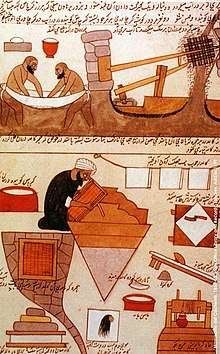
A highly valuable manuscript from the 13th century has also elaborated the process of papermaking in detailed. This text shows how papermakers went through a multitude of steps to produce a high-quality paper. This papermaking instruction or recipe is a chapter under the title of al-kâghad al-baladî (local paper) from the manuscript of al-Mukhtara'fî funûn min al-ṣunan attributed to al-Malik al-Muẓaffar, a Yemeni ruler of Rasulids. The bark of fig trees, as the main source of papermaking in this recipe, went through frequent cycles of soaking, beating and drying. The whole process that took 12 days was designed to produced 100 sheets of high-quality paper. During the pulping stage, the beaten fibres were transformed into different sizes of Kubba (cubes) which they were used as standard scales to manufacture a certain number of sheets. The dimensions were determined based on three citrus fruit: limun (lemon), utrunja (orange) and narenja (Tangerine). A summarized version of this detailed process is as below. Each procedure was repeated several times.
- Soaking paper in a pool
- Dewatering paper through squeezing and pressing
- Making balls from the pulp
- Pressing the balls
- Drying the paper by sticking them to the wall and exposing the final product into the sun[39]
Paper properties
Near Eastern paper is mainly characterized by sizing with a variety of starches such as rice, katira, wheat and white sorghum. Rice and white sorghum were more widely used.[40][39] Paper usually was placed on a hard surface and a smooth device called a mohreh was used to rub the starch against the paper until it becomes perfectly shiny.[41]
The laborious process of papermaking was refined and machinery was designed for bulk manufacturing of paper. Production began in Baghdad, where a method was invented to make a thicker sheet of paper, which helped transform papermaking from an art into a major industry.[42] The use of water-powered pulp mills for preparing the pulp material used in papermaking dates back to Samarkand in the 8th century.[43] The use of human/animal-powered paper mills has also been identified in Abbasid-era Baghdad during 794–795,[44] though this should not be confused with later water-powered paper mills (see Paper mills section below). The Muslims also introduced the use of trip hammers (human- or animal-powered) in the production of paper, replacing the traditional Chinese mortar and pestle method. In turn, the trip hammer method was later employed by the Chinese.[45] Historically, trip hammers were often powered by a water wheel, and are known to have been used in China as long ago as 40 BCE or maybe even as far back as the Zhou Dynasty (1050 BCE–221 BCE),[46] though the trip hammer is not known to have been used in Chinese papermaking until after its use in Muslim papermaking.[45]
Apart from large-scale and more mechanized paper manufacturers, small to medium-sized manufacturers had labour-intensive papermaking processes
By the 9th century, Muslims were using paper regularly, although for important works like copies of the revered Qur'an, vellum was still preferred.[47] Advances in book production and bookbinding were introduced.[48] In Muslim countries they made books lighter—sewn with silk and bound with leather-covered paste boards; they had a flap that wrapped the book up when not in use. As paper was less reactive to humidity, the heavy boards were not needed. By the 12th century in Marrakech in Morocco a street was named "Kutubiyyin" or book sellers which contained more than 100 bookshops.[49]
In 1035 a Persian traveler visiting markets in Cairo noted that vegetables, spices and hardware were wrapped in paper for the customers after they were sold.[50] Since the First Crusade in 1096, paper manufacturing in Damascus had been interrupted by wars, but its production continued in two other centres. Egypt continued with the thicker paper, while Iran became the center of the thinner papers. Papermaking was diffused across the Islamic world, from where it was diffused further west into Europe.[51] Paper manufacture was introduced to India in the 13th century by Arab merchants, where it almost wholly replaced traditional writing materials.[47]
Indian subcontinent
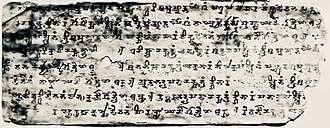
%2C_Sanskrit.jpg)
The evidence of paper use on the Indian subcontinent appears first in the second half of the 7th century.[15][54] Its use is mentioned by 7th– and 8th-century Chinese Buddhist pilgrim memoirs as well as some Indian Buddhists, as Kakali and Śaya – likely Indian transliteration of Chinese Zhǐ (tsie).[54][55] Yijing wrote about the practice of priests and laypeople in India printing Buddha image on silk or paper, and worshipping these images. Elsewhere in his memoir, I-Ching wrote that Indians use paper to make hats, to reinforce their umbrellas and for sanitation.[54] Xuangzang mentions carrying 520 manuscripts from India back to China in 644 CE, but it is unclear if any of these were on paper.[56]
Thin sheets of birch bark and specially treated palm-leaves remained the preferred writing surface for literary works through late medieval period in most of India.[56] The earliest Sanskrit paper manuscript found is a paper copy of the Shatapatha Brahmana in Kashmir, dated to 1089, while the earliest Sanskrit paper manuscripts in Gujarat are dated between 1180 and 1224.[57] Some of oldest surviving paper manuscripts have been found in Jain temples of Gujarat and Rajasthan, and paper use by Jain scribes is traceable to around 12th-century.[56] According to the historical trade-related archives such as Cairo Geniza found in the synagogues of the Middle East, Jewish merchants – such as Ben Yiju originally from Tunisia who moved to India – imported large quantities of paper into ports of Gujarat, Malabar coast and other parts of India by the 11th-century to partly offset the goods they exported from India.[58][59]
According to Irfan Habib, it is reasonable to presume that paper manufacturing reached Sindh (now part of south Pakistan) before 11th-century with the start of Arab rule in Sindh.[57] Fragments of Arabic manuscripts found in the Sindhi city ruins of Mansura, which was destroyed circa 1030, confirm the use of paper in Sindh.[57] Amir Khusrau of Delhi Sultanate mentions paper-making operations in 1289.[57]
In the 15th century, Chinese traveler Ma Huan praised the quality of paper in Bengal, describing it as white paper that is made from "bark of a tree" and is as "glossy and smooth as deer's skin".[60] The use of tree bark as a raw material for paper suggests that the paper manufacturing in the eastern states of India may have come directly from China, rather than Sultanates formed by West Asian or Central Asian conquests.[57] Paper technology likely arrived in India from China through Tibet and Nepal around mid-7th century, when Buddhist monks freely traveled, exchanged ideas and goods between Tibet and Buddhist centers in India.[54] This exchange is evidenced by the Indian talapatra binding methods that were adopted by Chinese monasteries such as at Tunhuang for preparing sutra books from paper. Most of the earliest surviving sutra books in Tibetan monasteries are on Chinese paper strips held together with Indian manuscript binding methods.[61] Further, the analysis of the woodblock book covers of these historic manuscripts has confirmed that it was made of tropical wood indigenous to India, not Tibet.[56]
Paper in Europe
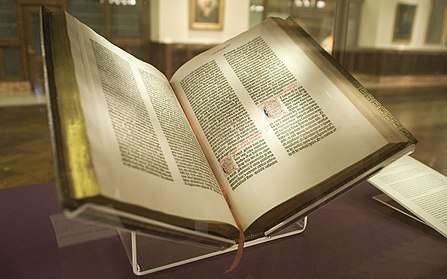
The oldest known paper document in Europe is the Mozarab Missal of Silos from the 11th century,[62] probably using paper made in the Islamic part of the Iberian Peninsula. They used hemp and linen rags as a source of fiber. The first recorded paper mill in the Iberian Peninsula was in Xàtiva in 1056.[63][64] Papermaking reached Europe as early as 1085 in Toledo and was firmly established in Xàtiva, Spain by 1150. It is clear that France had a paper mill by 1190, and by 1276 mills were established in Fabriano, Italy and in Treviso and other northern Italian towns by 1340. Papermaking then spread further northwards, with evidence of paper being made in Troyes, France by 1348, in Holland sometime around 1340–1350, in Mainz, Germany in 1320, and in Nuremberg by 1390 in a mill set up by Ulman Stromer.[65] This was just about the time when the woodcut printmaking technique was transferred from fabric to paper in the old master print and popular prints. There was a paper mill in Switzerland by 1432 and the first mill in England was set up by John Tate around 1490 near Hertford,[66][67] but the first commercially successful paper mill in Britain did not occur before 1588 when John Spilman set up a mill near Dartford in Kent.[68] During this time, paper making spread to Poland by 1491, to Austria by 1498, to Russia by 1576, to the Netherlands by 1586, to Denmark by 1596, and to Sweden by 1612.[29]
Arab prisoners who settled in a town called Borgo Saraceno in the Italian Province of Ferrara introduced Fabriano artisans in the Province of Ancona the technique of making paper by hand. At the time they were renowned for their wool-weaving and manufacture of cloth. Fabriano papermakers considered the process of making paper by hand an art form and were able to refine the process to successfully compete with parchment which was the primary medium for writing at the time. They developed the application of stamping hammers to reduce rags to pulp for making paper, sizing paper by means of animal glue, and creating watermarks in the paper during its forming process. The Fabriano used glue obtained by boiling scrolls or scraps of animal skin to size the paper; it is suggested that this technique was recommended by the local tanneries. The introduction of the first European watermarks in Fabriano was linked to applying metal wires on a cover laid against the mould which was used for forming the paper.[69]
They adapted the waterwheels from the fuller's mills to drive a series of three wooden hammers per trough. The hammers were raised by their heads by cams fixed to a waterwheel's axle made from a large tree trunk.[70][71]
Americas
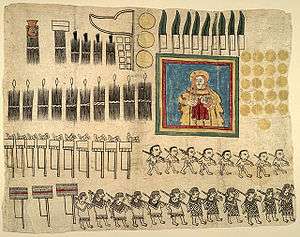
In the Americas, archaeological evidence indicates that a similar bark-paper writing material was used by the Mayans no later than the 5th century CE.[72] Called amatl or amate, it was in widespread use among Mesoamerican cultures until the Spanish conquest. The earliest sample of amate was found at Huitzilapa near the Magdalena Municipality, Jalisco, Mexico, belonging to the shaft tomb culture. It is dated to 75 BCE.[73]
The production of amate is much more similar to paper than papyrus. The bark material is soaked in water, or in modern methods boiled, so that it breaks down into a mass of fibres. They are then laid out in a frame and pressed into sheets. It is a true paper product in that the material is not in its original form, but the base material has much larger fibres than those used in modern papers. As a result, amate has a rougher surface than modern paper, and may dry into a sheet with hills and valleys as the different length fibres shrink.
European papermaking spread to the Americas first in Mexico by 1575 and then in Philadelphia by 1690.[29]
United States
The American paper industry began with the establishment of the first paper mill in British America in 1690 by William Rittenhouse of Philadelphia with the help of Pennsylvania's first printer, William Bradford. For two decades it would remain the only mill in the colonies, and for the next two centuries the city would remain the preeminent center of paper manufacturing and publishing. The first paper mills relied solely on rag paper production, with cotton rags generally imported from Europe. However by the mid-19th century the sulfite process had begun to proliferate in other regions with better access to wood pulp, and by 1880, America had become the largest producer of paper goods in the world. While the Delaware Valley remained an important region in paper production and publishing through the late nineteenth century, Philadelphia was overtaken by regions using these new processes which had greater access to water power and wood pulp.[74]
The earliest of these mills were centered in New England and Upstate New York, the latter of which became home to International Paper, the largest pulp and paper company in the world, which held a 20% market share in 2017,[75] and at its peak produced more than 60% of the continent's newsprint in 1898, before an industry shift to Canada.[76] Chief among papermaking cities in New England and the world was Holyoke, Massachusetts, at one time making 80% of the writing paper of the United States and home to the ill-fated American Writing Paper Company, the world's largest producer of fine papers by 1920.[77][78] By 1885 the Paper City, as it is still called, produced 190 tons per day, more than twice Philadelphia's capacity.[79] Quickly it became a hub of paper machinery and turbine technology, host to the largest paper mills in the world in the 1890s, and D. H. & A. B. Tower, the largest paper mill engineering firm in the United States in the 19th century.[80] The Tower Brothers and their associates would be responsible for designing mills on five continents.[81] In the United States the firm supported the Berkshires' paper industry, building the first mills used to make U.S. currency by the Crane Company, as well as the first sulfite process mills of Kimberly Clark in Wisconsin, allowing the company to be the first west of the Appalachians to adopt the process, with access to vast forest resources.[82][83]
The pulp and paper industry continued to develop in other regions, including California, Ohio's Miami Valley, with centers in Dayton, Hamilton, and Cincinnati, as well as regions of the South, like Texas and Georgia, the latter being home to Georgia Pacific and WestRock, the 2nd and 3rd respective largest paper producers in the United States today.[75][84] Wisconsin's industry nevertheless endured and as of 2019 it had far and away the most paper manufacturers in the country, with 34 such enterprises. While only smaller specialty manufacturers remained in Pennsylvania and New England, New York retained 28 mills, followed by Georgia with 20, Michigan with 17, and Alabama with 16 respectively.[85]
Paper mills
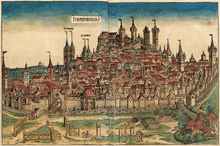
The use of human and animal powered mills was known to Chinese and Muslim papermakers. However, evidence for water-powered paper mills is elusive among both prior to the 11th century.[86][87][88][89] Scholars have identified paper mills, likely human or animal powered, in Abbasid-era Baghdad during 794–795.[44] It is evident that throughout the Islamic lands e.g. Iran, Syria (Hama and Damascus), and North Africa (Egypt and Tripoli) water power mills were extensively used to beat the flax and rag wastes to prepare the paper pulp [90]
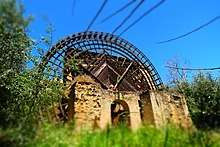
Donald Hill has identified a possible reference to a water-powered paper mill in Samarkand, in the 11th-century work of the Persian scholar Abu Rayhan Biruni, but concludes that the passage is "too brief to enable us to say with certainty" that it refers to a water-powered paper mill.[91] This is seen by Halevi as evidence of Samarkand first harnessing waterpower in the production of paper, but notes that it is not known if waterpower was applied to papermaking elsewhere across the Islamic world at the time.[92] Burns remains sceptical, given the isolated occurrence of the reference and the prevalence of manual labour in Islamic papermaking elsewhere prior to the 13th century.[93]
Clear evidence of a water-powered paper mill dates to 1282 in the Spanish Kingdom of Aragon.[94] A decree by the Christian king Peter III addresses the establishment of a royal "molendinum", a proper hydraulic mill, in the paper manufacturing centre of Xàtiva.[94] The crown innovation was operated by the Muslim Mudéjar community in the Moorish quarter of Xàtiva,[95] though it appears to have been resented by sections of the local Muslim papermakering community; the document guarantees them the right to continue the way of traditional papermaking by beating the pulp manually and grants them the right to be exempted from work in the new mill.[94] Paper making centers began to multiply in the late 13th century in Italy, reducing the price of paper to one sixth of parchment and then falling further; paper making centers reached Germany a century later.[96]
The first paper mill north of the Alps was established in Nuremberg by Ulman Stromer in 1390; it is later depicted in the lavishly illustrated Nuremberg Chronicle.[97] From the mid-14th century onwards, European paper milling underwent a rapid improvement of many work processes.[98]
Fiber sources
Before the industrialisation of the paper production the most common fibre source was recycled fibres from used textiles, called rags. The rags were from hemp, linen and cotton.[99] It was not until the introduction of wood pulp in 1843 that paper production was not dependent on recycled materials from ragpickers.[99] It was not realized at the time how unstable wood pulp paper is.
A means of removing printing inks from paper, allowing it to be re-used, was invented by German jurist Justus Claproth in 1774.[99] Today this process is called deinking.
19th-century advances in papermaking
Although cheaper than vellum, paper remained expensive, at least in book-sized quantities, through the centuries, until the advent of steam-driven paper making machines in the 19th century, which could make paper with fibres from wood pulp. Although older machines pre-dated it, the Fourdrinier papermaking machine became the basis for most modern papermaking. Nicholas Louis Robert of Essonnes, France, was granted a patent for a continuous paper making machine in 1799. At the time he was working for Leger Didot with whom he quarrelled over the ownership of the invention. Didot sent his brother-in-law, John Gamble, to meet Sealy and Henry Fourdrinier, stationers of London, who agreed to finance the project. Gamble was granted British patent 2487 on 20 October 1801. With the help particularly of Bryan Donkin, a skilled and ingenious mechanic, an improved version of the Robert original was installed at Frogmore Paper Mill, Hertfordshire, in 1803, followed by another in 1804. A third machine was installed at the Fourdriniers' own mill at Two Waters. The Fourdriniers also bought a mill at St Neots intending to install two machines there and the process and machines continued to develop.
However, experiments with wood showed no real results in the late 18th century and at the start of the 19th century. By 1800, Matthias Koops (in London, England) further investigated the idea of using wood to make paper, and in 1801 he wrote and published a book titled Historical account of the substances which have been used to describe events, and to convey ideas, from the earliest date, to the invention of paper.[100] His book was printed on paper made from wood shavings (and adhered together). No pages were fabricated using the pulping method (from either rags or wood). He received financial support from the royal family to make his printing machines and acquire the materials and infrastructure needed to start his printing business. But his enterprise was short lived. Only a few years following his first and only printed book (the one he wrote and printed), he went bankrupt. The book was very well done (strong and had a fine appearance), but it was very costly.[101][102][103]
Then in the 1830s and 1840s, two men on two different continents took up the challenge, but from a totally new perspective. Both Friedrich Gottlob Keller and Charles Fenerty began experiments with wood but using the same technique used in paper making; instead of pulping rags, they thought about pulping wood. And at about the same time, by mid-1844, they announced their findings. They invented a machine which extracted the fibres from wood (exactly as with rags) and made paper from it. Charles Fenerty also bleached the pulp so that the paper was white. This started a new era for paper making. By the end of the 19th-century almost all printers in the western world were using wood in lieu of rags to make paper.[104]
Together with the invention of the practical fountain pen and the mass-produced pencil of the same period, and in conjunction with the advent of the steam driven rotary printing press, wood based paper caused a major transformation of the 19th-century economy and society in industrialized countries. With the introduction of cheaper paper, schoolbooks, fiction, non-fiction, and newspapers became gradually available by 1900. Cheap wood based paper also meant that keeping personal diaries or writing letters became possible and so, by 1850, the clerk, or writer, ceased to be a high-status job.
Unfortunately, early wood-based paper deteriorated as time passed, meaning that much of the output of newspapers and books from this period either has disintegrated or is in poor condition; some has been photographed or digitized (scanned). The acid nature of the paper, caused by the use of alum, produced what has been called a slow fire, slowly converting the paper to ash. Documents needed to be written on more expensive rag paper. In the 2nd half of the 20th century cheaper acid-free paper based on wood was developed, and it was used for hardback and trade paperback books. However, paper that has not been de-acidified was still cheaper, and remains in use (2020) for mass-market paperback books, newspapers, and in underdeveloped countries.
Determining provenance
Determining the provenance of paper is a complex process that can be done in a variety of ways. The easiest way is using a known sheet of paper as an exemplar. Using known sheets can produce an exact identification. Next, comparing watermarks with those contained in catalogs or trade listings can yield useful results. Inspecting the surface can also determine age and location by looking for distinct marks from the production process. Chemical and fiber analysis can be used to establish date of creation and perhaps location.[105]
See also
| Wikimedia Commons has media related to History of paper. |
Notes
- Confusingly, parchment paper is a treated paper used in baking, and unrelated to true parchment.
References
- Barrett 2008, p. 34.
- "Papyrus definition". Dictionary.com. Retrieved 2008-11-20.
- Tsien 1985, p. 38
- Tsien 1985, p. 2
- David Buisseret (1998), Envisaging the City, U Chicago Press, p. 12, ISBN 978-0-226-07993-6
- Wilkinson 2012, p. 908.
- Papermaking. (2007). In: Encyclopædia Britannica. Retrieved April 9, 2007, from Encyclopædia Britannica Online.
- "eNewsletter". World Archeological Congress. August 2006. Retrieved 2010-07-08.
- Tsien 1985, p. 40 uses Wade-Giles transcription
- Tsien 1985, p. 122
- Tsien 1985, p. 1
- Tsien 1985, p. 123
- Tsien 1985, p. 105
- Barrett 2008, p. 36.
- Wilkinson 2012, p. 909.
- Barrett 2008, p. 37.
- Barret 2008, p. 37-38.
- Barrett 2008, p. 38.
- Barrett 2008, p. 39.
- Wilkinson 2012, p. 935.
- Wilkinson 2012, p. 934.
- Barret 2008, p. 40.
- DeVinne, Theo. L. The Invention of Printing. New York: Francis Hart & Co., 1876. p. 134
- Meggs, Philip B. A History of Graphic Design. John Wiley & Sons, Inc. 1998. (pp 58) ISBN 0-471-29198-6
- Quraishi, Silim "A survey of the development of papermaking in Islamic Countries", Bookbinder, 1989 (3): 29–36.
- Bloom, Jonathan (2001). Paper Before Print: The History and Impact of Paper in the Islamic World. New Haven: Yale University Press. pp. 8–10, 42–45. ISBN 0-300-08955-4.
- Paper-making and the exchange of ideas, Christine Baker, Indiana University of Pennsylvania, Quote: "The problem is: no one thinks this actually happened. Sources report that there was paper making in Central Asia at least fifty years before. Further, Chinese and Muslim civilizations made paper in different ways – there's no evidence that knowledge of how to make paper was transferred at this battle."
- Ibn Khaldun, Abd Ar Rahman (2015). Rosenthal, Franz (ed.). The Muqqadimah (PDF). Purity Publications.
- Harrison, Frederick. A Book about Books. London: John Murray, 1943. p. 79. Mandl, George. "Paper Chase: A Millennium in the Production and Use of Paper". Myers, Robin & Michael Harris (eds). A Millennium of the Book: Production, Design & Illustration in Manuscript & Print, 900–1900. Winchester: St. Paul’s Bibliographies, 1994. p. 182. Mann, George. Print: A Manual for Librarians and Students Describing in Detail the History, Methods, and Applications of Printing and Paper Making. London: Grafton & Co., 1952. p. 79. McMurtrie, Douglas C. The Book: The Story of Printing & Bookmaking. London: Oxford University Press, 1943. p. 63.
- Minorky, ed. (1937). Hodud Al-'Alam, The reigns of The world: A Persian Geography (PDF). Oxford: University Press.
- Al-Hamawi, Yagut (1381). Ayati, Muhammad (ed.). Mu'jam al-Udabā. Tehran: Soroush Publications. ISBN 964-7483-02-3.
- Ibn al-Nadim (1381). Tajadod, Reza (ed.). Alfehrest (in Persian). Tehran: Asatir Publications.
- Bloom, Jonathan M (1999). "Revolution by the Ream: A History of Paper". Aramco. 50 (3): 26–39.
- Bloom, Jonathan. M (2000). "The introduction of paper to the Islamic lands and the development of the illustrated manuscript". Muqarnas. 17: 17–23. doi:10.2307/1523287. JSTOR 1523287.
- Awwād, Korkis (1984). "al-Waraq wa'l-kāḡaḏ". Majallat Al-majmaʿ Al-ʿelmi Al-ʿarabi. 23.
- Ibn Nadim (1381). Tajadod, Reza (ed.). Alfehrest (in Persian). Asatir Publications.
- Mahgoub, Hend; Bardon, Stephanie; Lichtblau, Dirk; Tom, Fearn; Matija, Strlič (2016). "Material Properties of Islamic Paper". Heritage Science. 4 (34). doi:10.1186/s40494-016-0103-4.
- Penley, Knipe; Katherine, Eremi; Walton, Marc; Babini, Agnese; Rayner, Georgina (2018). "Materials and techniques of Islamic manuscripts". Heritage Science. 6 (55). doi:10.1186/s40494-018-0217-y.
- Gacek, Adam (2002). "On the Making of Local Paper: A Thirteenth Century Yemeni Recipe". Revue des mondes musulmans et de la Meiterranee. doi:10.4000/remmm.1175.
- Jamali Yazdi, Abu Bakr (1386). Afshar, Iraj (ed.). Farrokh Nameh. Tehran: Amir Kabir (published 2007). ISBN 9640010642.
- Jöns, Heike; Meusburger, Peter; Heffernan, Michael (2017). "Chapter 3: Papermaking: The Historical Diffusion of an Ancient Technique". Mobilities of Knowledge. Springer International Publishing. pp. 51–66.
- Mahdavi, Farid (2003), "Review: Paper Before Print: The History and Impact of Paper in the Islamic World by Jonathan M. Bloom", Journal of Interdisciplinary History, MIT Press, 34 (1): 129–30, doi:10.1162/002219503322645899
- Lucas, Adam (2006), Wind, Water, Work: Ancient and Medieval Milling Technology, Brill Publishers, pp. 65 & 84, ISBN 90-04-14649-0
- Burns 1996, p. 414
- Dard Hunter (1978), Papermaking: the history and technique of an ancient craft, Courier Dover Publications, ISBN 0-486-23619-6
- Needham, Joseph (1986). Science and Civilization in China: Volume 4, Part 2. p. 184.
- Fischer, Steven R. (2004), A History of Writing, London: Reaktion Books, p. 264, ISBN 1-86189-101-6
- Al-Hassani, Woodcock and Saoud, "1001 Inventions, Muslim heritage in Our World", FSTC Publishing, 2006, reprinted 2007, pp. 218-219.
- The famous Kutubiya mosque is named so because of its location in this street
- Diana Twede (2005), "The Origins of Paper Based Packaging" (PDF), Conference on Historical Analysis & Research in Marketing Proceedings, 12: 288–300 [289], archived from the original (PDF) on July 16, 2011, retrieved 2010-03-20
- Mahdavi, Farid (2003), "Review: Paper Before Print: The History and Impact of Paper in the Islamic World by Jonathan M. Bloom", Journal of Interdisciplinary History, MIT Press, 34 (1): 129–30, doi:10.1162/002219503322645899
- Claus Vogel (1979). A History of Indian Literature. Otto Harrassowitz Verlag. pp. 309 with footnotes. ISBN 978-3-447-02010-7.
- "The Weber MSS – Another collection of ancient manuscripts from Central Asia". Journal of the Asiatic Society of Bengal (1): 1–40. 1893.;
A. F. Rudolf Hoernle (1897). Three further collections of ancient manuscripts from Central Asia (JASB, Vol LXVI, Part 1, Number 4). Asiatic Society of Bengal. - Tsien 1985, pp. 2–3, 356–357
- D. C. Sircar (1996). Indian Epigraphy. Motilal Banarsidass. pp. 67–68. ISBN 978-81-208-1166-9.
- Agnieszka Helman-Ważny (2014). The Archaeology of Tibetan Books. BRILL Academic. pp. 49–60. ISBN 978-90-04-27505-8.
- Habib, Irfan (2011). Economic History of Medieval India, 1200-1500. Pearson Education India. pp. 95–96. ISBN 9788131727911.
- Roxani Margariti (2014). Arnold Franklin (ed.). Jews, Christians and Muslims in Medieval and Early Modern Times: A Festschrift in Honor of Mark R. Cohen. BRILL Academic. pp. 54–55 with footnotes 40–41. ISBN 978-90-04-26784-8.
- Bloom, Jonathan (2001). Paper Before Print: The History and Impact of Paper in the Islamic World. Yale University Press. p. 78. ISBN 0-300-08955-4.
- SAK Ghori; A Rahman (1966). "Paper Technology in medieval India". Indian Journal of History of Science. 2: 135–136.
- Yi Xumei; Lu Xiuwen (2010). Susan M. Allen; Lin Zuzao; Cheng Xiaolan; Jan Bos (eds.). The History and Cultural Heritage of Chinese Calligraphy, Printing and Library Work. Walter de Gruyter. pp. 59–61. ISBN 978-3-598-44179-0.
- Crespo, Carmen; Vinas, Vincente (1984). "The Preservation and Restoration of Paper Records and Books: A RAMP Study with Guidelines" (PDF). United Nations Educational, Scientific and Cultural Organization. p. 3 note 1. Retrieved 2013-07-10.
- Richard Leslie Hills: Papermaking in Britain 1488–1988: A Short History. Bloomsbury Publishing, 2015, ISBN 978-1-4742-4127-4 (Reprint), S. 2.
- Filipe Duarte Santos: Humans on Earth: From Origins to Possible Futures. Springer, 2012, ISBN 978-3-642-05359-7, S. 116.
- Fuller, Neathery Batsell (2002). "A Brief history of paper". Retrieved 2011-01-24.
- Richard L. Hills, ‘Tate, John (c.1448–1507/8)’, Oxford Dictionary of National Biography, Oxford University Press, 2004; online edn, Jan 2008 accessed 24 June 2015. Subscription or UK public library membership required.
- Historie ručního papíru
- "Dartford, cradle of Britain's papermaking industry". Retrieved 2011-01-24.
- Hills, Richard (1936). "Early Italian papermaking : a crucial technical revolution": 37–46. hdl:10079/bibid/11263265. Cite journal requires
|journal=(help) - Papiernicze, Rękodzieło; Dąbrowski, Józef (1991). "The Papermaking Craft": 152. Cite journal requires
|journal=(help) - Dabrowski, Jozef (July 2008). "Paper Manufacture in Central and Eastern Europe Before the Introduction of Paper-making Machines" (PDF): 6. Cite journal requires
|journal=(help) - The Construction of the Codex In Classic- and post classic-Period Maya Civilization Maya Codex and Paper Making
- Benz, Bruce; Lorenza Lopez Mestas; Jorge Ramos de la Vega (2006). "Organic Offerings, Paper, and Fibers from the Huitzilapa Shaft Tomb, Jalisco, Mexico". Ancient Mesoamerica.== 17 (2). pp. 283–296.
- McCarthy, Jack. "Paper and Papermaking". The Encyclopedia of Greater Philadelphia. Camden, N.J.: Rutgers University. Archived from the original on May 2, 2020.
- "Market share of the leading paper manufacturers in the United States in 2017". statista. April 2018. Archived from the original on June 10, 2020.
- Study of monopoly power : hearings before the Subcommittee on Study of Monopoly Power of the Committee on the Judiciary, House of Representatives. Washington, D.C.: United States Government Printing Office. 1950. p. 600.
- Root, Joshua L. (Fall 2009). "Something Will Drop: Socialists, Unions and Trusts in Nineteenth-Century Holyoke" (PDF). Historic Journal of Massachusetts. 37 (2): 38. Archived from the original (PDF) on December 24, 2017.
- "Stabilizing the Paper Industry, A Lesson for Those Who Will Learn". Pulp and Paper Magazine of Canada. Vol. XIX. June 16, 1921. p. 635.
- "Eight Paper Towns". The Inland Printer. Vol. II no. 10. Chicago. July 1885.
- "Emory Alexander Ellsworth". Journal of the Boston Society of Civil Engineers. III (8): 480. October 1916.
In 1879 Mr. Ellsworth left the firm of Davis & Ellsworth to become principal assistant and head draftsman for D. H. & A. B. Tower, of Holyoke, who were the largest firm of paper mill architects in the country at that time, and who designed no less than twenty paper mills in the city of Holyoke alone.
- Tower, J.W. (1902). "Memoir of Ashley Bemis Tower". Transactions of the American Society of Civil Engineers. 49 (941): 361.
- "Manufacturing and Technical". Engineering News-record. XXIII: 528. May 31, 1890.
Six Hennessey Boilers, made by the B. F. Hawkins Iron Works, of Springfield, Mass., are showing remarkable results at the Kimberly & Clark paper mills, Appleton, Wis...The entire plant was designed by D. H. & A. B. Tower, of Holyoke, Mass.
- Heinrich, Thomas; Batchelor, Bob (2004). "Origins and Growth, 1872-1916". Kotex, Kleenex, Huggies: Kimberly-Clark and the Consumer Revolution in American Business. Columbus: The Ohio State University Press. pp. 20–22. ISBN 9780814209769.
- Weeks, Lyman Horace (1916). A History of Paper-manufacturing in the United States, 1690-1916. Lockwood Trade Journal Company. p. 271.
- An Assessment of the Economic Contribution of Pulp, Paper and Converting to the State of Wisconsin (PDF) (Report). Wisconsin Economic Development Corporation; University of Wisconsin - Stevens Point. August 5, 2019. pp. 16–20. Archived from the original (PDF) on October 30, 2019.
- Tsien, Tsuen-Hsuin 1985, pp. 68–73
- Lucas 2005, p. 28, fn. 70
- Burns 1996, pp. 414f.:
It has also become universal to talk of paper "mills" (even of 400 such mills at Fez!), relating these to the hydraulic wonders of Islamic society in east and west. All our evidence points to non-hydraulic hand production, however, at springs away from rivers which it could pollute.
- Thompson 1978, p. 169:
European papermaking differed from its precursors in the mechanization of the process and in the application of water power. Jean Gimpel, in The Medieval Machine (the English translation of La Revolution Industrielle du Moyen Age), points out that the Chinese and Muslims used only human and animal force. Gimpel goes on to say : "This is convincing evidence of how technologically minded the Europeans of that era were. Paper had traveled nearly halfway around the world, but no culture or civilization on its route had tried to mechanize its manufacture."'
- Jöns, H (2017). "Papermaking: The Historical Diffusion of an Ancient Technique". Mobilities of Knowledge. Knowledge and Space. 10. Springer International Publications. pp. 51–66. doi:10.1007/978-3-319-44654-7_3. ISBN 978-3-319-44653-0.
- Donald Routledge Hill (1996), A history of engineering in classical and medieval times, Routledge, pp. 169–71, ISBN 0-415-15291-7
- Leor Halevi (2008), "Christian Impurity versus Economic Necessity: A Fifteenth-Century Fatwa on European Paper", Speculum, Cambridge University Press, 83 (4): 917–945 [917–8], doi:10.1017/S0038713400017073
- Burns 1996, pp. 414−417
- Burns 1996, pp. 417f.
- Thomas F. Glick (2014). Medieval Science, Technology, and Medicine: An Encyclopedia. Routledge. p. 385. ISBN 9781135459321.
- Burns 1996, p. 417
- Stromer 1960
- Stromer 1993, p. 1
- Göttsching, Lothar; Pakarinen, Heikki (2000), "1", Recycled Fiber and Deinking, Papermaking Science and Technology, 7, Finland: Fapet Oy, pp. 12–14, ISBN 952-5216-07-1
- Koops, Matthias. Historical account of the substances which have been used to describe events, and to convey ideas, from the earliest date, to the invention of paper. London: Printed by T. Burton, 1800.
- Carruthers, George. Paper in the Making. Toronto: The Garden City Press Co-Operative, 1947.
- Matthew, H.C.G. and Brian Harrison. "Koops. Matthias." Oxford Dictionary of National Biography: from the earliest times to the year 2000, Vol. 32. London: Oxford University Press, 2004: 80.
- Burger, Peter. Charles Fenerty and his Paper Invention. Toronto: Peter Burger, 2007. ISBN 978-0-9783318-1-8 pp.30–32
- Burger, Peter. Charles Fenerty and his Paper Invention. Toronto: Peter Burger, 2007. ISBN 978-0-9783318-1-8
- Suarez, S.J., Michael F.; Woudhuysen, H.R. (2013). The Book: A Global History. OUP Oxford. ISBN 9780199679416.
Sources
- Barrett, Timothy Hugh (2008), The Woman Who Discovered Printing, Great Britain: Yale University Press, ISBN 978-0-300-12728-7 (alk. paper)
- Bloom, Jonathan (2001). Paper before print: the history and impact of paper in the Islamic world. Yale University Press.
- Burns, Robert I. (1996), "Paper comes to the West, 800–1400", in Lindgren, Uta (ed.), Europäische Technik im Mittelalter. 800 bis 1400. Tradition und Innovation (4th ed.), Berlin: Gebr. Mann Verlag, pp. 413–422, ISBN 3-7861-1748-9
- Febvre, Lucien; Martin, Henri-Jean (1997), The Coming of the Book: The Impact of Printing 1450–1800, London: Verso, ISBN 1-85984-108-2
- Lucas, Adam Robert (2005), "Industrial Milling in the Ancient and Medieval Worlds. A Survey of the Evidence for an Industrial Revolution in Medieval Europe", Technology and Culture, 46 (1): 1–30, doi:10.1353/tech.2005.0026
- Stromer, Wolfgang von (1960), "Das Handelshaus der Stromer von Nürnberg und die Geschichte der ersten deutschen Papiermühle", Vierteljahrschrift für Sozial und Wirtschaftsgeschichte, 47: 81–104
- Stromer, Wolfgang von (1993), "Große Innovationen der Papierfabrikation in Spätmittelalter und Frühneuzeit", Technikgeschichte, 60 (1): 1–6
- Thompson, Susan (1978), "Paper Manufacturing and Early Books", Annals of the New York Academy of Sciences, 314 (1): 167–176, Bibcode:1978NYASA.314..167T, doi:10.1111/j.1749-6632.1978.tb47791.x
- Tsien, Tsuen-Hsuin (1985), Paper and Printing, Joseph Needham, Science and Civilisation in China, Chemistry and Chemical Technology, Vol. 5 part 1, Cambridge University Press
- Wilkinson, Endymion (2012), Chinese History: A New Manual, Harvard University Asia Center for the Harvard-Yenching Institute
